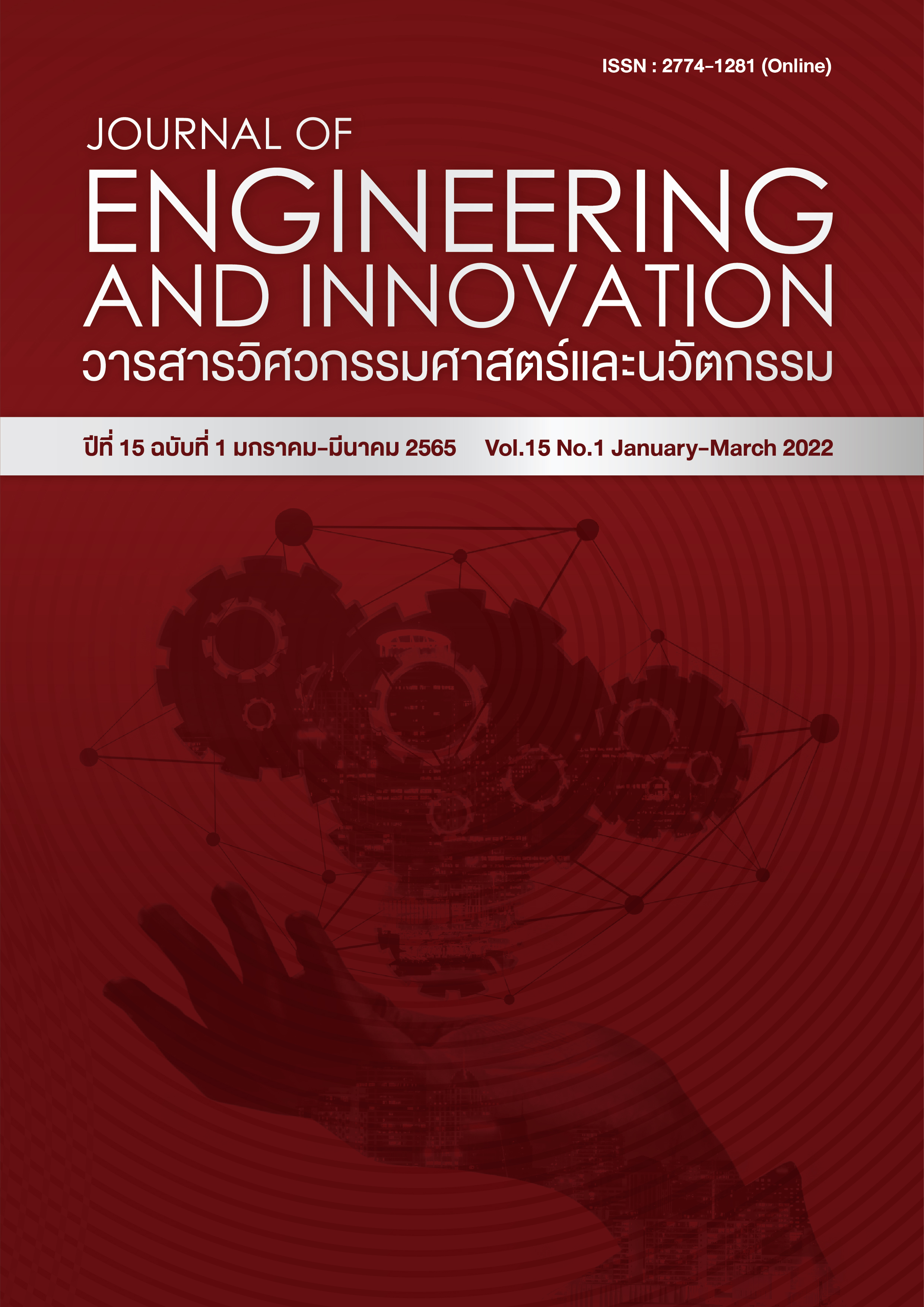การบูรณาการระหว่างเกณฑ์มาตรฐานประสิทธิภาพพลังงานขั้นต่ำ และการประเมิน วัฏจักรชีวิตในการปรับปรุงกรอบอาคาร กรณีศึกษา อาคารผู้ป่วยนอก โรงพยาบาลสารภี
Main Article Content
บทคัดย่อ
งานวิจัยนี้นำเสนอรูปแบบการปรับปรุงกรอบอาคารเพื่อให้ได้อาคารที่เป็นมิตรต่อสิ่งแวดล้อม ตามเกณฑ์มาตรฐานประสิทธิภาพพลังงานขั้นต่ำ ผนวกกับการประเมินวัฏจักรชีวิต ด้านการปล่อยก๊าซเรือนกระจกในช่วงของการผลิตวัสดุที่ใช้ในการปรับปรุง และการใช้ไฟฟ้าระบบปรับอากาศ ซึ่งเป็นผลมาจากรูปแบบของกรอบอาคาร ดังนั้นผู้วิจัยได้กำหนดรูปแบบทางเลือกของกรอบอาคารเพื่อหาแนวทางที่ดีที่สุดจากการทดลองในโปรแกรม BEC Web-Base และการคำนวณปริมาณการปล่อยก๊าซเรือนกระจกโดยอ้างอิงจากการคำนวณจากคณะกรรมการระหว่างรัฐว่าด้วยการเปลี่ยนแปลงสภาพอากาศ ในบทความวิจัยนี้จะนำเสนอแนวทางในการปรับปรุงของอาคารผู้ป่วยนอก โรงพยาบาลสารภี ซึ่งเป็นโรงพยาบาลชุมชนที่ใช้แบบมาตรฐานอาคารผู้ป่วยนอกเลขที่ 3130 ที่มีค่าการถ่ายเทความร้อนของผนัง และหลังคาไม่ผ่านเกณฑ์มาตรฐานประสิทธิภาพพลังงานขั้นต่ำ ผลการวิจัยพบว่า แนวทางที่ดีที่สุดในส่วนของผนัง คือการติดตั้งผนังยิปซั่มพร้อมกับฉนวนกันความร้อน ความหนาแน่น 12 กก./ลบ.ม. (หนา 65 มม.) และการติดตั้งฉนวนกันความร้อน ความหนาแน่น 24 กก./ลบ.ม. (หนา 25 มม.) ภายใต้หลังคาเดิม ทำให้อาคารมีค่าการถ่ายเทความร้อนรวมของผนัง และหลังคาเท่ากับ 24.55 W/m2 และ 8.56 W/m2 ตามลำดับ ซึ่งผ่านเกณฑ์มาตรฐานประสิทธิภาพพลังงานขั้นต่ำ แม้ว่าแนวทางการปรับปรุงทำให้มีปริมาณการปล่อยก๊าซเรือนกระจกที่เกิดจากวัสดุรวม 1,507.07 kgCO2e แต่ทำให้อาคารสามารถลดปริมาณก๊าซเรือนกระจกจากการใช้ไฟฟ้าระบบปรับอากาศได้ปีละ 7,818.61 kgCO2e นอกจากนี้ผลกำไรจากการขายคาร์บอนเครดิตจากการลดปริมาณการปล่อยก๊าซเรือนกระจก และค่าไฟฟ้าที่ลดลงสามารถคืนทุนจากต้นทุน ในระยะเวลา 1.20 ปี ทั้งนี้ในการศึกษาต่อไปผู้วิจัยเสนอให้พิจารณาทางด้านผลกระทบต่อสิ่งแวดล้อมในทุกช่วงวัฏจักรชีวิตของอาคาร เพื่อให้ได้ข้อสรุปที่ชัดเจนยิ่งขึ้น
Article Details
เอกสารอ้างอิง
แนวทางเบื้องต้นในการออกแบบอาคารอนุรักษ์พลังงานประสิทธิภาพสูงเชิงสถาปัตยกรรม. German International Cooperation. 2016. Available from: https://www.thai-german-cooperation.
info/th/giz-eppo-launched-an-architectural-guidebook-for-high-energy-efficient-building-design/.[Accessed 15th November 2020]
เกณฑ์มาตรฐานประสิทธิภาพพลังงานขั้นต่ำ ตามประกาศกระทรวงพลังงาน เรื่อง หลักเกณฑ์ และวิธีการคํานวณในการออกแบบอาคารแต่ละระบบ การใช้พลังงานโดยรวมของอาคาร และการใช้พลังงานหมุนเวียนในระบบต่าง ๆ ของอาคาร พ.ศ. 2552. กระทรวงพลังงาน; 2552.
Pongyen N, Waroonkun T. Design guidelines for improving outpatient building of a community hospital in order to increase satisfaction. Journal of Environmental Design. 2014;1(2):49-80.
Roumchat T. Improving community hospital by using green building guidelines and standard for healthcare: Silpakorn University.
Ridthplake S, Boonkham W. Greenhouse gasses (carbon dioxide gas) assessment from municipal solid waste management system in ban-yang, buriram province. Journal of Energy and Environment Technology of Graduate School Siam Technology College. 2020;7(1):29-37.
Bec web-based. Ministry of energy. 2018. Available from: https://bec.energy.in.th/dash
board#.[Accessed 16th October 2020]
Chaichana S. Renovation strategies to improve energy saving for provincial health office. Veridian E-Journal, Silpakorn University (Humanities, Social Sciences and arts). 2016;9
(1):1703-16.
กฎกระทรวงฉบับที่ 11 2528.
Tuhus-Dubrow D, Krarti M. Genetic-algorithm based approach to optimize building envelope design for residential buildings. Building and environment. 2010;45(7):1574-81.
Sharma A, Saxena A, Sethi M, Shree V. Life cycle assessment of buildings: A review. Renewable and Sustainable Energy Reviews. 2011;15(1):871-5.
Suwan C, Somjai T. Comparative greenhouse gas evaluation of house construction: A conventional house versus an interlocking block house. The Journal of KMUTNB. 2020;30(4):570-7.
Onestockhome co., ltd. 2020. Available from: https://www.onestockhome.com/th.[Accessed 15th October 2020]
Carbon footprint of product. Carbon label & carbon footprint for organization. Available from: http://thaicarbonlabel.tgo.or.th/products
_approval/products_approval.pnc.[Accessed 9th October 2020]
Surachotivet T. Anlysis life cycle energy of building construction : A case study multi-purpose building of silpakorn university,” graduate school. Bangkok, Thailand: Silpakorn University; 2018.
kitsiri. 2020. Available from: https://www.
cementhaihomemart.com/?___store=en&___from_store=th.[Accessed 11st October 2020]
Home product center public company limited. 2020. Available from: https://www.homepro
.co.th/.[Accessed 11 Nov 2020]
Gupta MY. Carbon credit: A step towards green environment. Global Journal of Management and Business Research. 2011;11(5).
Volume and turnover of carbon credits from the t-ver project. Thailand Greenhouse Gas Management Organization. 2020. Available from: http:// carbonmarket.tgo.or.th/#weekly.
[Accessed 14th October 2020]

